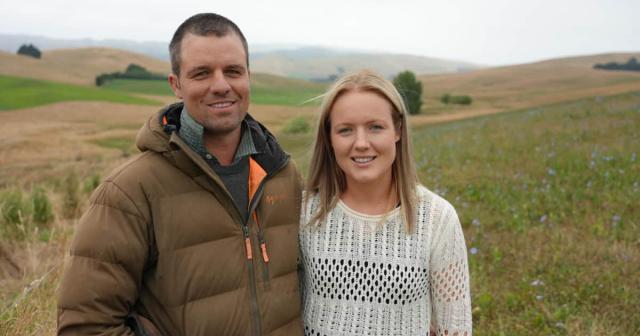A can-do attitude, parental support and a drive to create multi-generational opportunities have been instrumental in helping North Canterbury farmers Jim and Kim Burrows build a business in the sheep and beef industry.

Keys to their success
- Strong relationships.
- Clarity and focus. Kim says they were always clear about wanting to build a business that would offer their two children future opportunities. They have strong, clear goals.
- They challenge their decisions. Particularly when something doesn’t feel right.
- They leverage their assets and think in the long-term.
- They make every dollar work for them. They invest in assets that enable them to build their equity. This includes land and livestock.
- They understand who they work with and know how members of their team operate.
The young couple’s presentation was one of the highlights of the annual Beef + Lamb New Zealand’s Marlborough Farming for Profit Dinner held in Blenheim recently.
They described how they had built their 1570ha business from scratch and while Jim was brought up on dairy farms, he discovered his love for the sheep and beef industry soon after leaving school and was determined to build a future in the sector.
What he did learn from his dairy farming parents was a strong work ethic and an ability to be very careful with money.
Jim was rearing and selling calves before leaving school, so had money in the bank from an early age, and while cutting his teeth in the sheep and beef industry as a young shepherd, he was continuing to rear heifer calves and trade dairy cattle. He was also investing in the stock market.
Kim, who is an accountant, was taught at a young age to be financially independent and as a teenager, was lending her hard-earned cash to her brothers at a respectable interest rate. Her willingness to work hard, combined with her financial smarts, meant she left university with accumulated funds.
When the pair got together, they had $100, 000 between them with which they bought dairy cows. These cows were leased back to Jim’s parents and the couple eventually built their herd to 100 in-milk cows. These cows represented their capital. Jim was also trading lambs on vineyards while working in Marlborough.
In 2017, the couple began formal succession planning with Jim’s parents Paul and Mandy. Neither Jim, nor his brother, wanted to go dairy farming, but Jim says his parents just wanted to help their children in any way they could.
“We thought it was going to be more uncomfortable than it actually was,” says Jim.
Faciliated by a solicitor, the discussions gave all parties clarity about the opportunities available to them.
“The goal was to help us into the business early, while protecting relationships. If you are thinking about succession, start the conversation well before you think you need to.”
Jim and Kim both credit Jim’s parents for their support in helping the couple achieve their farm ownership goals, which began with Glenlake farm in Glenmark Drive in Waipara.
Mandy and Paul sold their Southland dairy farm to help finance the couple into the 670ha farm and Jim and Kim sold all of their dairy trading stock, which was the deposit for livestock and plant. The bank financed the balance.
A year after buying the property, a neighbour’s farm came up for sale which, with the encouragement of their bank, they bought, growing their land holding to 840ha.
With a clear focus on generating a profit, reducing debt and running a business they could be “proud to showcase”, the couple operated a very lean operation, not employing any staff and always looking for any opportunity to make money.
“We aim to keep it simple; we don’t employ any staff, we have low farm working expenses and high output.”
They run high-performing composite ewes alongside trading stock and make every mouthful count. They also keep personal spending very low.
The couple are proud of their ability to remain profitable even in drought and generate enough spare cash to make principal repayments.
Having paid off so much debt so quickly, Jim and Kim were looking for investment opportunities both on and off-farm and explored a number of options before a 730ha farm at Waiau came up for sale last year.
The couple say they were initially lukewarm on the idea, but after viewing the property, they liked it and bought in. They now have a manager on the farm.
Between the two farms, the Burrows are now running 6,000 ewes and hoggets and 200 breeding cows. They sell yearling bulls, trade between 3000-5000 store lambs and 300 cattle.
Jim says they continue to focus on running conservative stocking rates while striving to get maximum production and margins out of every stock unit. They use trading stock to mop up surplus feed and have strong relationships with two stock agents who keep an eye out for trading opportunities for them.